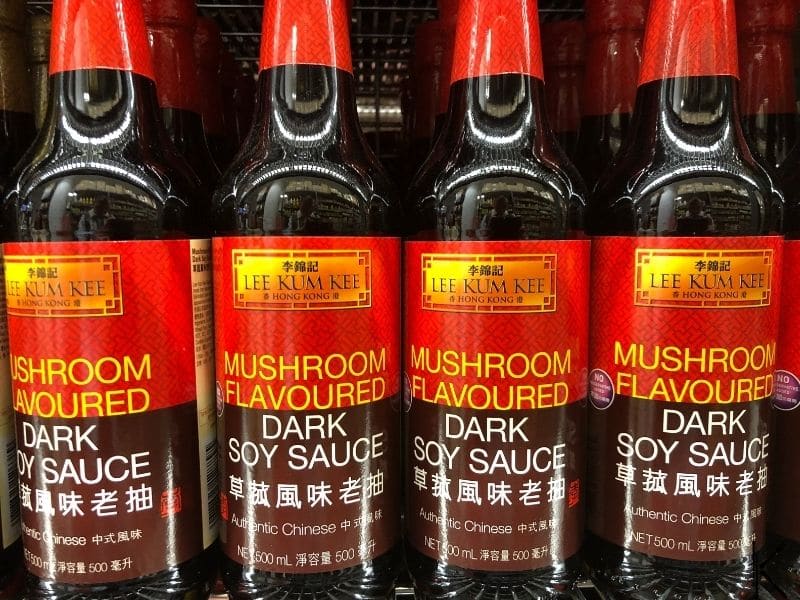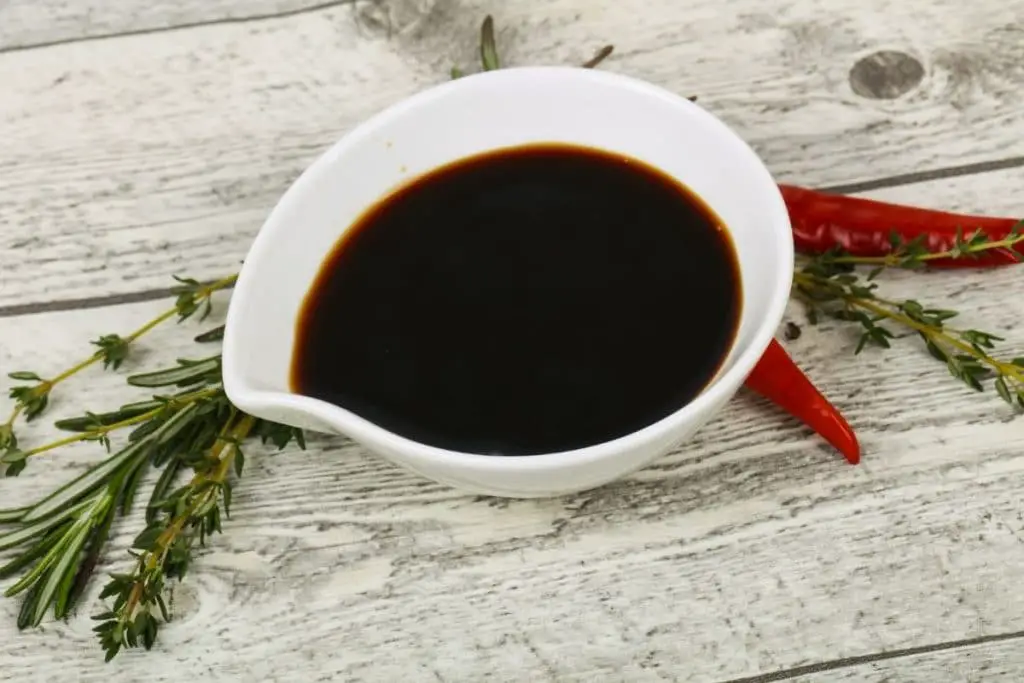In a nutshell, the best replacements for soy sauce are: tamari, Worcestershire sauce, coconut aminos, liquid aminos, dried mushrooms, etc… I will tell you how much to use and how to use it below. Each substitute has a different flavor profile and should be used in different amounts in different meals to get the taste you want.
With its rich salty flavor, soy sauce brings a boost of umami to a variety of savory dishes. Sushi, dumplings, and stir-fry are simply incomplete without their unique and complex depth.
Soy sauce is definitely a pantry hero. It does however contain gluten, high sodium, and of course soy which can all be a problem for people with allergies or who need to watch their salt intake.
Whether you’ve run out of this sauce or need to avoid it for health reasons, there are other ways to achieve the same depth of flavor without the high sodium and wheat components of soy sauce. In this guide, you’ll learn how to choose the best soy sauce substitute for your favorite recipes.
Types of Soy Sauce
Also known as shoyu sauce, traditional soy sauce is Chinese in origin and made from a fermented paste of soybeans, wheat, brine, and a mold called kōji. This salty brown liquid traditionally takes months to produce.
The soybeans are soaked and cooked. It is mixed with roasted, crushed wheat, and koji and then left to brew in brine. The fermented product is pressed to drain out the liquid which is pasteurized and bottled as soy sauce.
It comes in many varieties including sweet, dark, light, or low-sodium, thick soy sauce, and flavored varieties.
This versatile sauce can be added as a marinade, sauce, or as a seasoning. From steamed rice and saute vegetables to fried eggs, seafood, poultry, broths, salad dressings, stir fry, and curry, it is an incredibly handy ingredient to have around.

The Best Soy Sauce Replacement
Although soy sauce alternatives may have a comparable flavor, they won’t necessarily be an exact match. Always add slightly less of the soy sauce alternative and increase the amount to taste slowly as salt levels can become intense very quickly if you’re not careful.
1. Tamari
Tamari is the closest tasting substitute since it is made in a very similar way with fermented soybeans. It does not contain wheat so is an ideal alternative if you are wheat or gluten intolerant.
It is however advisable to check the label since some brands may contain a trace amount of wheat.
If you are not worried about a soy allergy and don’t need to monitor your sodium intake, this is the best soy sauce substitute to use. Replace the sauce in a 1:1 ratio.
Best used in: Any dish that calls for soy sauce
Related: What can I use instead of tamari?
2. Worcestershire Sauce
Worcestershire sauce is a fermented sauce of British origin with a similar dark brown color to that of regular soy sauce. It contains a blend of malt vinegar, spices, sugar, salt, anchovies, garlic, onions, molasses, and tamarind extract. It adds the same depth of flavor to dishes, but with a less salty and more vinegary taste.
Most brands are soy- and gluten-free and lower in sodium, making it an ideal substitute for health reasons. However, if you are allergic to shellfish or seafood, give Worcestershire sauce a skip.
Best used in: Dishes that require soy sauce for added flavor but not for saltiness, since Worcestershire sauce is less salty. Stews and marinades are ideal.
3. Coconut Aminos
Coconut aminos is a sauce made from fermented coconut sap. Its similar umami flavors makes it an ideal alternative with a slightly sweeter undertone.
If you are watching your sodium intake, coconut aminos is a good substitute option since it is much lower in sodium at 90 milligrams per teaspoon compared to 290 milligrams in soy sauce.
It is also gluten-free, however, always check the specific brand’s label. Coconut aminos are usually available from health food stores, well-stocked supermarkets, or can be purchased online.
Best used in: Any recipe where you require a substitute
See more: Coconut aminos substitute
4. Liquid Aminos
Liquid aminos are made from soybeans but unlike soy sauce, it is not fermented. It is a gluten-free liquid protein concentrate with a similar sodium content and taste to that of soy sauce, although it is slightly milder and a bit sweeter.
Best used in: Any recipe where you require a substitute, especial keto recipes.
5. Dried mushrooms
Dried shiitake mushrooms can be found in most grocery stores and are naturally gluten- and soy-free as well as being low in sodium. Mushrooms will need to be rehydrated in water or for the best results in your cooking liquid such as stew or soup.
If you are using the mushrooms to replace soy sauce in a dish such as stir fry, rehydrate the mushrooms well in a small amount of boiling water and use the soaking liquid in your dish.
Although the flavor intensity will be much milder and it does not replicate the exact flavor, dried mushrooms will bring a great umami depth to your dish.
Best used in: Recipes that require a small amount of soy sauce since the flavor will be milder
6. Fish Sauce
Fish sauce is popularly used in Asian dishes. It is very flavorful and will have a pungent fishy flavor if you use too much. Use slightly less when adding fish sauce your recipe as a soy sauce replacement. It is made from salt fermented fish or krill and has a deep umami quality.
Best used in: Any recipe where you require a substitute
7. Miso Paste
Miso is a thick paste made in a similar way to soy sauce from fermented soybeans, salt, and kōji. Some varieties may use grains such as barley or rice in the production process. Miso paste has a high salt level and should be diluted in water or liquid.
Use small amounts and make sure the paste is completely dissolved and blended through the other ingredients before tasting and adjusting your quantities as it can easily overpower your dish.
Best used in: Soups, stews, and sauces, allowing the miso paste to dissolve into the liquid.
8. Maggi Seasoning
Maggi sauce is comparable to a liquid version of vegemite. This Swiss condiment is made from fermented wheat proteins. It is potent, salty, and packed with umami flavor. Add it to your dish in small increments and adjust according to taste.
Best used in: Any recipe where you require a substitute
9. Anchovies
Anchovies don’t provide an exact flavor match to soy sauce and may not be suitable in all recipes, but they can definitely add a well-rounded savory depth to sauces, marinades, and curries. Finely chop a few anchovies into stews or sauces and mix well to blend and break down completely.
Best used in: Sauces that require cooking, giving the anchovies a chance to mix and dissolve into the dish
10. Salt
Although salt does not add the umami depth that soy sauce offers, it does allow your ingredients to shine when seasoned in proportion. Use just a pinch to sprinkle over or mix well into the rest of the ingredients when you don’t have soy sauce on hand.
If soy sauce in your recipe is important for adding a complex depth of flavor, salt probably won’t do it justice, and it may be better to go with another option.
Best used in: Recipes that don’t rely on soy sauce for a depth of complex flavors, but only for its saltiness
11. Homemade Soy Sauce
A great option, especially if you want to control the ingredients in your sauce for allergy purposes, is to make your own homemade substitute. In this case, you can use gluten-free or low-sodium versions of the ingredients required in the recipe to custom make your soy sauce to suit your needs. Here is what you will need:
Ingredients:
- 2 tablespoons regular or low-sodium beef bouillon
- 1 teaspoon dark molasses
- 1 teaspoon apple cider vinegar
- Pinch of ground ginger
- Pinch of garlic powder
- Freshly ground black pepper, to taste
Directions
- Combine the ingredients
Combine all the ingredients except the pepper in a small saucepan with ¾ cup water and heat over medium-high heat.
- Simmer and reduce
Bring the mixture to a boil and then lower the temperature and simmer until the liquid is reduced to your preferred flavor strength. This should take 10 to 12 minutes.
- Season
Add a few cracks of ground black pepper according to taste. You can keep the mixture in the refrigerator for around 5 days.
Best used in: Any recipe where you require a substitute
FAQs
Conclusion
Soy sauce is a fantastic pantry staple to use in marinades, dressings, dipping sauces, and seasoning in many savory dishes. There are a range of suitable alternatives to use if you have a soy or wheat allergy or need to watch your sodium intake.
Great options for people avoiding soy due to allergies are Worcestershire sauce, dried mushrooms, and coconut aminos. Wheat-free alternatives include Worcestershire sauce, tamari, homemade soy sauce, dried mushrooms, and anchovies.
Whichever replacement you use, start with small amounts and add to taste. Experiment with different options – you might just discover a new burst of umami flavor you love.
See more: Does soy sauce go bad?
*image by AndreySt/depositphotos









